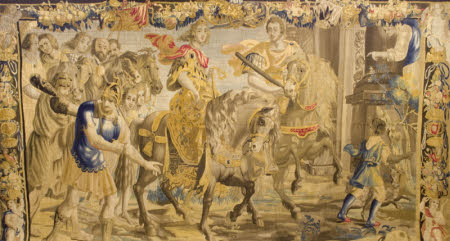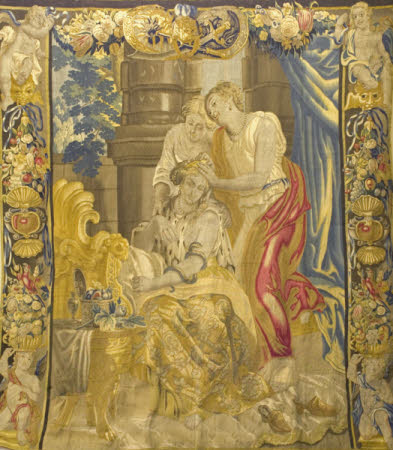The Story of Antony and Cleopatra
probably Antwerp
Category
Tapestries
Date
circa 1670 - circa 1680
Materials
Tapestry, wool and silk, 6 warps per cm
Place of origin
Belgium
Order this imageCollection
Sizergh Castle, Cumbria
NT 998628
Summary
Tapestry, wool and silk, 6 warps per cm, from a set of five of The Story of Antony and Cleopatra, probably Joris Rombouts, Antwerp, c. 1670-1680.
Full description
The five ‘Antony and Cleopatra’ tapestries at Sizergh are the largest surviving weaving of a series produced in Antwerp in the 1670s. They tell the story of the love affair of Cleopatra, Queen of Egypt (r. 51-30 BC) and the Roman General Mark Antony (c. 83-30 BC). The main source for the story is Plutarch’s ‘Life of Antony’ in his ‘Parallel Lives’ (c. 100). Cleopatra inherited the throne of Egypt jointly with her brother in 51 BC. In 48 BC she met Julius Caesar and became his mistress, and with Caesar’s support she was established as sole Queen of Egypt. After Caesar’s death (44 BC) Egypt became involved in the Roman Civil War and in 41 BC Cleopatra was summoned to meet the Roman politician and General Mark Antony. She so charmed him that he stayed with her in Alexandria and they became lovers. The first meeting of the couple is the subject of 998628.3. Cleopatra’s growing claims to power made Rome increasingly uneasy, and at the same time relations between Mark Antony and Octavian, his fellow Triumvir (and later known as Augustus, the first Emperor of Rome), were disintegrating. In 33 BC Octavian and the Roman Senate declared war on Egypt, and in 31 BC the Roman Fleet routed Mark Antony’s forces and Cleopatra’s own fleet at the Battle of Actium. Although there is no solid basis for the story, later accounts state that Cleopatra and Mark Antony took flight from the battle together, and this may be the subject of 998628.1. Octavian then invaded Egypt, and Mark Antony fled yet again when his troops refused to fight for him. After this defeat Mark Antony committed suicide, and when negotiations with Octavian failed Cleopatra killed herself as well, according to many accounts with the venomous bite of an asp – the subject of the last tapestry at Sizergh, 998628.5. The designer of the tapestry series is not known, but as Forti-Grazzini notes the designs rely heavily on another set of ‘Antony and Cleopatra’ tapestries designed in 1649-50 by Justus van Egmont (1601-1674), one of the most influential Flemish tapestry designers of the second half of the seventeenth century (Forti-Grazzini 1994, p. 350). Van Egmont’s set of designs was woven in Brussels and numerous editions survive dating from the 1650s and 1660s (see Brosens 2008, pp. 138-165; Standen 1985, vol. 1, pp. 206-217). The five tapestries at Sizergh bear no makers’ marks. Forti-Grazzini convincingly suggests on the basis of style and execution that the Antony and Cleopatra series was produced in Antwerp rather than Brussels, and makes an attribution to the little-known Antwerp weaver Joris Rombouts (1649 – after 1679). This is based on the records of the art dealers the Forchoudts in the late seventeenth century, which show that Joris Rombouts supplied tapestries of ‘Antony and Cleopatra’ to their agent in Vienna in 1675; a set of eight tapestries of the same subject appears in a bill from Rombouts in c. 1670 (Denucé 1931, pp. 128, 195, 276). Rombouts was born in Oudenaarde, the second-largest tapestry-producing town in the Netherlands, in 1649, and moved to Antwerp where he married the daughter of the famous tapestry merchant Peter van der Goes. Rombouts ran a successful Antwerp enterprise, producing and selling tapestries of the ‘Story of Moses’, the ‘Story of Joseph’, the ‘Story of Diana’, the ‘Story of Darius’, a set of ‘Landscapes with Small Figures’ and another of ‘Landscapes’ designed by Pieter de Witte (Duverger 1977, p. 278; Denucé 1931, pp. 183, 186, 195, 276, 288). Despite his considerable activity, the ‘Mark Antony and Cleopatra’ series is the only one that has been attributed to him, a situation which may be due to the fact that he did not sign his work. Forti-Grazzini dates the Quirinale tapestry to c. 1670-80 on the basis that the series is first recorded in Rombouts’s catalogue in c. 1670 and 1675, and that he is last recorded as active in 1679. Since Rombouts was only born in 1649 the tapestries cannot date from much before 1670. Forti-Grazzini was the first author to attempt to reconstruct Rombouts’s ‘Antony and Cleopatra’ series, in his catalogue entry for a version of the ‘Flight of Mark Antony and Cleopatra’ in the Palazzo del Quirinale, Rome (Forti-Grazzini 1994, cat. no. 130, pp. 530-1). The Quirinale tapestry replicates the design of 998628.1, but with minor differences including the omission of the soldier and shield lying on the ground beneath the horses’ feet. The Quirinale panel has a similar upper border to the five Sizergh tapestries with swags of fruit between flags and military paraphernalia, but the side borders are different, and are composed of a plinth supported by a lion at the bottom with herms decked in flowers in the centre and putti blowing trumpets at the top corners. The Quirinale ‘Flight’ originated in the Medici tapestry collection, and Forti-Grazzini identifies two further tapestries from the same set, now dispersed: ‘Cleopatra and the Pearl’ in the Palazzo della Provincia (the former Medici Palace) in Siena (Ciatti & Avanzati 1990, pp. 274, 285 and fig. 7.16), and a ‘Suicide of Cleopatra’ in the Palazzo Pitti, catalogued as the ‘Toilette of Cleopatra’ (never published; Alinari Photo no. 30652). Forti-Grazzini further speculates that two tapestries sold at Sotheby’s, London, 12 July 1968, lots 40 and 41 were also from the same series, since the description of one of them closely matches the ‘Flight’ scene. Forti-Grazzini was unaware of the five tapestries at Sizergh, but the description of the second Sotheby’s tapestry closely matches the ‘Triumph of Antony and Cleopatra’ at Sizergh. Two further tapestries can be added to the five at Sizergh and those identified by Forti-Grazzini: weavings of ‘The Flight of Antony and Cleopatra’ and ‘The Flight of Cleopatra’ in the National Trust’s collection at Powis Castle, with borders matching the set at Sizergh (1181008.1, 2). These tapestries were made between c. 1670 and 1678 for the alcove of the State Bedroom at Powis where they still hang. (Helen Wyld, 2012)
Credit line
Sizergh Castle, The Hornyold-Strickland Collection (The National Trust)
Makers and roles
probably Antwerp , workshop probably Joris Rombouts (Oudenaarde, 1649 – d. after 1679), workshop
References
Brosens, 2008: Koenraad Brosens, European Tapestries in the Art Institute of Chicago, New Haven and London 2008 Forti-Grazzini, 1994: Nello Forti-Grazzini, Gli Arazzi (Il patrimonio artistico del Quirinale), 2 vols., Rome 1994 Ciatti and Avanzati, 1990: Marco Ciatti and Elisabetta Avanzati, ‘Gli Arazzi’, in Fabio Bisogni (ed.), Il Palazzo della Provincia di Siena, Rome 1990, pp. 273-304 Edith A Standen, European Post Medieval Tapestries in the Metropolitan Museum of Art, 2 vols., New York 1985 Duverger, 1977: Erik Duverger, ‘Antwerp Tapestries of the Seventeenth Century’, The Connoisseur, vol. 195 (April 1977), pp. 274-87 Denucé, 1931: Jean Denucé, Kunstuitvoer in de 17e eeuw te Antwerpen: de firma Forchoudt, Antwerp 1931


